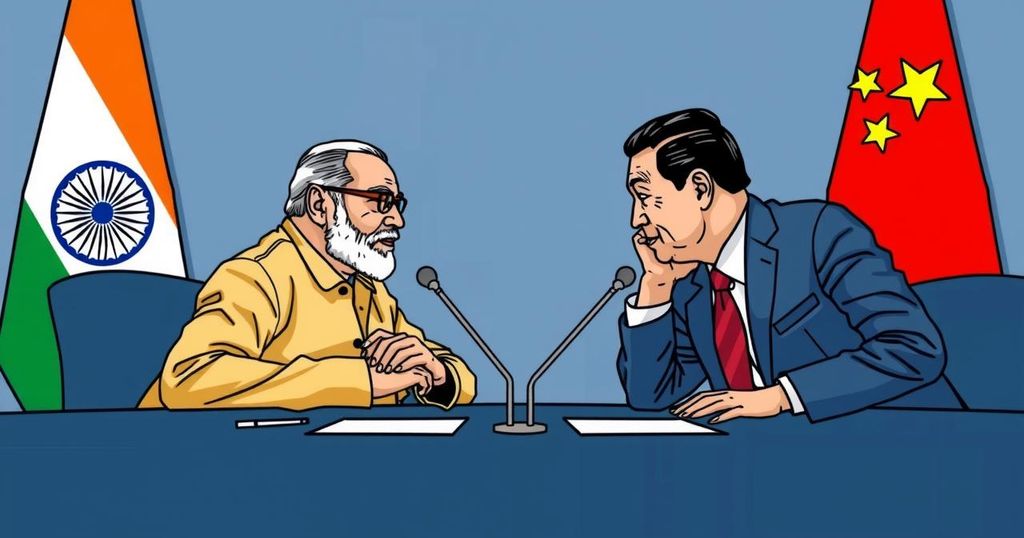Diplomatic Negotiation Success: Understanding the India-China LAC Patrolling Agreement
The article outlines the successful negotiations between India and China that led to the resumption of patrolling rights in contested areas of East Ladakh, stemming from discussions between Prime Minister Modi and President Xi. Following military tensions post-2020, the agreement indicates a careful diplomatic approach taken to ease border tensions, while addressing broader geopolitical implications. It emphasizes the importance of continued negotiations to ensure stability and prevent military confrontations in the future.
The recent agreement facilitating patrolling in the Depsang Bulge and Demchok areas of East Ladakh reflects intensive diplomatic engagements between India and China, primarily spearheaded by Prime Minister Narendra Modi and President Xi Jinping. This development comes after a prolonged period of military friction that escalated following the People’s Liberation Army’s (PLA) transgressions in May 2020. The dialogues that transpired, especially the Modi-Xi meeting in Kazan and subsequent Special Representative talks, were pivotal in establishing a framework for military de-escalation of the 3,488 km Line of Actual Control (LAC). The Working Mechanism for Consultation and Coordination on India-China Border Affairs (WMCC) played a crucial role in these negotiations, conducting 17 meetings since the violent clashes at Galwan in June 2020. Military leaders on both sides also engaged in 21 rounds of talks to achieve disengagement and resume patrolling. Following an agreement on September 9, 2022, regarding the disengagement in the Gogra-Hot Springs-Khugrang Nullah region, India emphasized restoring patrolling rights in Depsang Bulge and Demchok as a prerequisite for normalization of ties. Despite criticism from the opposition, which pointed to the establishment of buffer zones and questioned the terms of the agreement, the Indian Army remains committed to active patrolling in these contested areas in the future. It is essential to note that the buffer zones are temporary arrangements intended to stabilize tensions rather than permanent solutions. The agreement’s scope has been confined to the Western Sector, where the armies had faced direct confrontations along the 1,597-kilometer boundary in East Ladakh. The ongoing agreement enables India to gain diplomatic leverage and reduces the risk of China being treated as a vulnerability by other powers. Furthermore, Prime Minister Modi’s stance throughout this situation enhances his credibility as a leader who stood firm against Chinese military buildup across various sectors of the LAC. As both nations prepare for the practical implementation of this patrolling agreement, the context remains complex due to the heavy troop and military asset presence on both sides, necessitating further negotiations on de-escalation. India and China must now decide on troop withdrawals to pre-tension levels, with the threat of extreme weather conditions in East Ladakh posing additional challenges for forces enduring a prolonged military standoff. The ramifications of past military engagements, particularly the 1962 war, continue to shape the current geopolitical landscape, underscoring the importance of robust political and military leadership in addressing unresolved border issues. As the dialogue unfolds between PM Modi and President Xi, the expectation is a restraint in unilateral actions from the PLA, with a focus on fostering mutual trust and respect in bilateral relations.
The article examines the Sino-Indian military standoff that commenced in May 2020, following aggressive maneuvers by the People’s Liberation Army in the disputed areas of East Ladakh. The critical role of diplomacy and military negotiations between India and China is highlighted, particularly the successful facilitation of a patrolling agreement in high-stakes territories. The historical context of border disputes and past conflicts, including the significant implications of the 1962 Sino-Indian War, informs the contemporary challenges and strategies both nations face in navigating their complex relationship along the LAC.
The agreement to resume military patrolling in disputed border areas represents a critical step in stabilizing Sino-Indian relations. Highlighting the comprehensive negotiations involved, this development marks a significant diplomatic achievement for India. However, continued vigilance and strategic dialogue will be necessary to maintain peace and prevent future escalations as both nations navigate their ongoing military presence along the contested LAC.
Original Source: www.hindustantimes.com








Post Comment